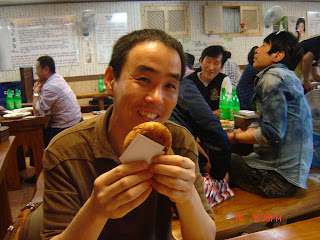Busan 1: Nampo-dong
前回の投稿で書いた約束を果たすため、釜山へ発つ。
彼女たち二人は、ホテルのロビーで待っていてくれた。滞在先は釜山駅の近くで南浦洞(ナッポドン)という繁華街を散策し、夕食を食べることになった。
南浦洞(ナッポドン)はいくつもの通りが歩行者天国になっており、日本の屋台のような出店が日中から夜半まで営業していて、いつも人でにぎわっている場所である。
そこで最初に勧められたのが、下の写真の駄菓子である。小麦粉か米粉かどちらかで練った生地の中にピーナッツとペースト状の黒糖を詰めた後、鉄板に油をしいて焼いたものだ。焼いた香ばしさと黒砂糖の甘みが絶妙な一品だった。値段は一個100円程度。
On June 14, I took a flight to Busan, Korea's second biggest city to discover more Korean culture and people. Shortly after my arrival, I took an airport shuttle bus to the city center to see Suri and her friend who I met on the airplane to Hong Kong, last month.
I had booked a hotel near the main railway station by following her recommendation few days before my departure. After exchanging hellos, we walked to Nampo-dong (南浦洞), a popular spot for hangouts for young Busan people to eat out.
We first the most popular street food called "hotteok", fried pancake with a filling of peanuts and brown sugar paste. A dough is knelt by hand and the filling is quickly placed inside before forming a shape of a small ball. Then the ball is place on a heated plate and pressed down to become flat.
This pancake is sweet. After quereing to buy it, we went to a small restaurant to take some pancake mixed with vegetable, seafood and meat.
This type of Korean pancake for a meal is called "jeon". The region of Busan is famous for leek pancake called "pajeon" (the first picture below). Hundreds years agon, this pancake was only made and served to the Royal families. There was a ritual on March 3rd to present this pancake to the King.
In 1930s, eating this legendary pancake has become customary to common people in Korea.
韓国のお好み焼きは日本で『チヂミ』いうが、韓国語で一般的に使われている名前ではないようで韓国では『Jeon(ジョン)』という。『Jeon(ジョン)』の中でも、この地域特産の葱を使ったものを『Pajeon(パジョン)』という。釜山を訪れたときには、必ず食べるべき、この地方の料理である。朝鮮王朝時代には王族に献上された逸品で1930年代以降一般人にも食されるようになったが今でも釜山で人気のある料理のようである。
Unlike Japanese pancake which is served with a large amount of thick sauce and mayonais that result in feeling "too much" or "too heavy", after eating a half, you eat the Korean pancake by dipping a light soy sauce. So, I like it very much.
Next one is an ordinary "jeon" with pork and vegetable.
次は、日本でも馴染みのある豚肉の入った『ジョン=チヂミ』。お好み焼きのように卵入っていないため、以前はあまりおいしいと感じなかったが、韓国で現地の韓国人がおいしいという店で食べると、一度で好きになった。日本のお好み焼き店では、ソースとマヨネーズをたっぷりかけるようにチューブの容器に入ってテーブルに置かれているが、自分はソースだけを少しかける程度している。それは、食べている途中においしく感じなくなるからだ。一方、韓国の『ジョン=チヂミ』は醤油ベースのあっさりしたタレに浸けて食べるため、飽きはあまり来ないで食べられた。
This one is known as "chijimi" in Japan and it is one of popular Korean food among Japanese. To accompany these dishes, we had "makgeolli", a traditional Korean liquor.
酒はやはり『マッコリ』が一番合う。
マッコリで乾杯。 少し発音は違うが韓国語でも『乾杯』と言うらしい。先に英語は世界をつなぐ言葉といった表現をしたが、スイスや北欧を除き、外国語である英語がだれにでも通じる国はないだろう。彼女たちとはジェスチャーも交えての会話だった。より多くの人たちと知り合うには英語だけでは難しい。やはり、その国の言葉ができて初めてわかる部分もある。特に人や文化に関して深く知ろうとすれば言葉は重要なカギである。
韓国語は日本語に文法的には近いとはいえ、ヨーロッパ言語のように英語で学んだ知識で容易にマスターできるものではない。まずは、会話とテレビのニュースやドラマが理解できることを中心に勉強しようか、、、






+(%ED%8C%8C%EC%A0%84)_001.JPG)
+(%EC%B0%8C%EC%A7%90)_001.JPG)


0 Comments:
Post a Comment
<< Home